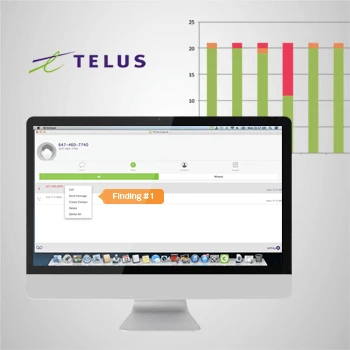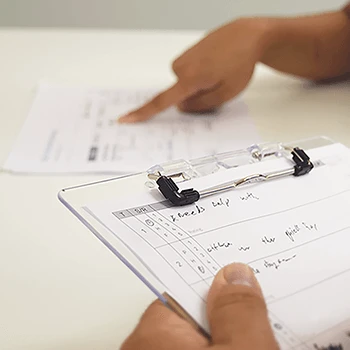What exactly is service experience testing and why do we need it for our business?
Service experience testing validates how well your service delivery meets customer needs across all touchpoints before full implementation. Unlike product usability testing that focuses on individual interfaces, service experience testing examines human interactions, spatial environments, process flows, and technology integration. Within our Experience Thinking framework, testing ensures brand, content, product, and service experiences work together seamlessly rather than creating friction points that damage customer relationships.
Tip: Focus initial testing on your highest-impact customer touchpoints where service failures would cause the most damage to relationships.
How does service experience testing differ from traditional usability testing?
Service experience testing encompasses human interactions, physical spaces, process workflows, and multi-touchpoint journeys while usability testing typically focuses on digital interface functionality. Service testing includes service staging, service walkthrough, and service role playing to test complete experience delivery systems. Testing reveals how staff, customers, technology, and environments interact throughout service journeys rather than isolated task completion within single products.
Tip: Use service experience testing when your business involves multiple touchpoints, human interactions, or physical service delivery components.
What business problems does service experience testing solve most effectively?
Service experience testing effectively addresses service delivery inconsistencies, operational inefficiencies, customer experience gaps, and staff performance issues before they impact real customers. Testing reveals disconnects between planned service delivery and actual customer experiences. It identifies where service innovations don't fit existing operations and where customer expectations aren't met. Testing also validates whether service improvements actually enhance customer satisfaction and business outcomes.
Tip: Focus testing efforts on service areas with highest customer complaints or operational challenges for maximum business impact.
What service experience testing methods work best for different situations?
Service staging tests complete service scenarios with real participants in controlled environments. Service walkthrough evaluates service delivery processes step-by-step with stakeholders and customers. Service role playing explores interaction dynamics between staff and customers. Each method within Experience Thinking framework tests different aspects: human interactions, operational processes, spatial design, and technology integration. Method selection depends on service complexity, risk levels, and implementation timeline.
Tip: Start with service walkthrough for process validation, then use service staging for complete experience testing before launch.
When should service experience testing occur in the development process?
Service experience testing should occur early in concept stages using prototypes and mock-ups, during detailed design phases with service blueprints, and before full launch with pilot implementations. Early formative testing guides design decisions while later summative testing validates readiness for market launch. Continuous testing throughout development prevents costly redesigns and ensures service delivery meets customer expectations from day one.
Tip: Conduct formative testing as soon as you have enough service design to support key customer scenarios, even with paper prototypes.
What role does foresight design play in service experience testing?
Foresight design enhances service experience testing by exploring how service delivery might need to adapt to future customer behaviors, technology changes, and market conditions. Rather than just testing current service concepts, foresight design helps validate service flexibility and resilience across different future scenarios. This approach creates more robust service designs that remain effective as customer expectations and competitive landscapes evolve over time.
Tip: Include scenario-based testing that explores how your service would perform under different future conditions and customer behavior changes.
How detailed should service experience testing be without overwhelming participants or teams?
Service experience testing should balance realism with participant comfort through structured scenarios that capture essential service interactions without unnecessary complexity. Testing environments should feel authentic while remaining manageable for observation and feedback collection. Clear testing protocols, defined participant roles, and focused scenarios help maintain engagement while generating actionable insights about service delivery effectiveness and customer satisfaction.
Tip: Design testing scenarios around your most critical customer journeys rather than trying to test every possible service interaction.
What research methods support effective service experience testing design?
Service experience testing research combines observational studies, stakeholder interviews, service journey analysis, and operational assessment to inform testing design. Research includes understanding current service delivery, identifying pain points, mapping customer expectations, and analyzing competitive service standards. Mixed methods ensure testing scenarios reflect real customer needs and operational constraints while revealing opportunities for service innovation and improvement.
Tip: Observe actual service interactions before designing tests to ensure testing scenarios reflect realistic customer behaviors and expectations.
How do we recruit appropriate participants for service experience testing?
Service experience testing requires participants representing actual customer segments, service delivery staff, and relevant stakeholders who influence service experiences. Recruitment should capture demographic diversity, experience levels, technology comfort, and service usage patterns. Include both existing customers and prospects to understand acquisition and retention perspectives. Staff participants should represent different roles and experience levels in service delivery.
Tip: Recruit participants who match your actual customer personas rather than just convenient volunteers to ensure realistic testing results.
What sample sizes work best for different types of service experience testing?
Service experience testing typically requires 8-12 participants per customer segment for qualitative insights, with larger samples for quantitative validation. Service staging may need fewer participants due to complexity while service walkthrough can accommodate larger groups. Sample size depends on service complexity, testing objectives, risk tolerance, and available resources. Multiple testing rounds often provide better insights than single large studies.
Tip: Start with smaller participant groups to identify major issues, then expand testing for validation and edge case exploration.
How do we test service experiences across multiple channels and touchpoints effectively?
Multi-channel service testing requires coordinated scenarios that capture customer journeys across digital platforms, physical locations, phone support, and staff interactions. Testing should include channel transitions, information continuity, and consistent service quality expectations. Experience Thinking methodology ensures testing reveals how brand, content, product, and service elements connect across touchpoints rather than optimizing channels in isolation.
Tip: Map complete customer journeys across channels and test the handoff points where service quality is most vulnerable to breakdown.
What metrics and measurements should we use in service experience testing?
Service experience testing metrics include task completion rates, service quality satisfaction, emotional response indicators, efficiency measures, and staff performance assessments. Quantitative metrics capture behavioral outcomes while qualitative measures reveal emotional and contextual insights. Metrics should align with business objectives and customer value definitions. Measurement frameworks help prioritize improvements and track testing effectiveness over time.
Tip: Establish baseline measurements for key service metrics before testing to accurately assess improvement opportunities and validate design changes.
How do we capture emotional and contextual aspects during service experience testing?
Emotional and contextual capture requires observation techniques, real-time feedback tools, post-interaction interviews, and environmental analysis during testing sessions. Video recording, emotion tracking, journey mapping, and critical incident analysis reveal how context influences service experiences. Within Experience Thinking framework, testing should capture both functional service delivery and emotional relationship building throughout customer interactions.
Tip: Use multiple data collection methods during testing sessions to capture both what happens and how participants feel about service interactions.
What timeline should we expect for thorough service experience testing?
Service experience testing typically requires 6-10 weeks including test design, participant recruitment, scenario development, testing sessions, analysis, and recommendation development. Timeline depends on service complexity, number of touchpoints tested, participant availability, and validation requirements. Multiple testing rounds may extend timelines but provide more robust insights. Rush testing often misses critical service delivery issues that emerge during realistic interactions.
Tip: Plan for iterative testing cycles rather than single large studies to accommodate design refinements and validation needs.
How do we align service experience testing with current business objectives and priorities?
Service experience testing alignment begins with understanding business goals, competitive challenges, operational constraints, and customer satisfaction targets before designing testing approaches. Tests should directly inform key performance indicators, service quality standards, and strategic initiatives. Experience Thinking methodology helps align testing insights across brand positioning, content strategy, product development, and service delivery objectives to ensure research creates actionable business value.
Tip: Start testing projects by identifying specific business decisions that service experience insights need to inform.
What stakeholders should be involved in service experience testing planning and execution?
Service experience testing requires input from customer service, operations, marketing, IT, staff training, and leadership stakeholders who influence service delivery quality. Front-line staff provide operational insights while customers offer experience perspectives. Including diverse stakeholders ensures testing addresses various organizational requirements and gains broader support for resulting service improvements. Cross-functional involvement also facilitates implementation of testing insights.
Tip: Create stakeholder maps showing how each group will use testing insights to ensure scenarios capture their specific decision-making needs.
How do service experience testing results inform investment and resource allocation decisions?
Service experience testing results inform investment decisions by revealing which service improvements generate highest customer value, operational efficiency, and competitive advantage. Testing identifies quick wins, strategic initiatives, and areas requiring significant resource commitment. Cost-benefit analysis of testing insights guides prioritization and budget allocation. Results also help justify service innovation investments through demonstrated customer impact and business outcome improvements.
Tip: Connect testing insights to specific business metrics and revenue opportunities to build compelling cases for service improvement investments.
What organizational changes might be needed to implement service experience testing insights?
Implementing service experience testing insights often requires changes in staff training programs, service standards, technology systems, and performance measurement approaches. Organizations may need customer experience roles, cross-functional collaboration protocols, and service delivery processes reflecting testing insights. Cultural shifts toward customer-centricity support successful implementation. Change management ensures testing insights translate into operational improvements rather than remaining theoretical recommendations.
Tip: Plan organizational change management alongside testing to ensure insights translate into sustainable service delivery improvements.
How do we build business cases that justify investment in service experience testing?
Business cases for service experience testing should quantify potential improvements in customer satisfaction, retention rates, operational efficiency, and competitive positioning. Calculate costs of service failures, customer churn, and missed opportunities that testing could prevent. Include competitive analysis showing how superior service experiences create market advantages. ROI projections should reflect both risk mitigation and revenue enhancement potential from improved service delivery.
Tip: Include competitive analysis showing how service experience advantages create market differentiation that justifies testing investment.
What return on investment can we expect from service experience testing initiatives?
Service experience testing ROI typically manifests through reduced service failures, improved customer satisfaction scores, increased retention rates, and operational efficiency gains. Organizations often see 20-40% improvements in service quality metrics and 15-25% reductions in service delivery costs. Revenue impact comes from better customer experiences, increased loyalty, and premium pricing enabled by superior service quality. Testing also prevents costly service failures and redesigns.
Tip: Track both quantitative metrics and qualitative improvements in customer relationships to capture full ROI impact from testing investments.
How do service experience testing insights support strategic planning and competitive positioning?
Service experience testing insights support strategic planning by revealing service differentiation opportunities, operational capability requirements, and market positioning advantages. Testing identifies where service excellence creates competitive moats and where improvements enable new market opportunities. Within foresight design frameworks, testing helps anticipate future service requirements and build adaptive capabilities that maintain competitive advantage as markets evolve.
Tip: Use testing insights to identify service capabilities that competitors cannot easily replicate rather than just fixing obvious service problems.
How do service experience testing results translate into actual service design improvements?
Service experience testing results translate into improvements through specific design applications like service blueprint updates, staff training modifications, process workflow redesigns, and technology system enhancements. Within Experience Thinking methodology, testing insights inform how brand, content, product, and service experiences connect to create seamless customer journeys. Implementation requires systematic integration into existing operations and new service delivery standards based on testing insights.
Tip: Create improvement roadmaps that prioritize testing insights by customer impact and implementation feasibility for systematic service enhancement.
What service design patterns and best practices emerge from testing insights?
Service experience testing reveals design patterns like effective staff-customer interaction protocols, seamless handoff procedures, recovery strategies for service failures, and optimal physical environment configurations. Best practices include clear expectation setting, progress communication, personalization opportunities, and consistent quality across touchpoints. Experience Thinking patterns ensure all service elements work together rather than creating conflicting customer experiences.
Tip: Document successful service patterns from testing as reusable design templates for future service development and staff training programs.
How do we prioritize service improvements based on testing findings?
Service improvement prioritization balances customer impact severity, business value potential, implementation complexity, and strategic alignment. High-impact, low-effort improvements provide quick wins while strategic initiatives address fundamental service redesign. Customer value assessment considers both functional improvements and emotional experience enhancement. Business value includes satisfaction improvements, cost reductions, competitive advantages, and operational efficiency gains identified through testing.
Tip: Create prioritization frameworks that balance customer pain severity with business opportunity size to guide improvement investments effectively.
What training and capability building are needed to implement testing insights?
Implementing testing insights requires staff training on new service standards, customer interaction protocols, technology usage, and problem resolution approaches. Training programs should cover emotional intelligence, service recovery, cross-functional collaboration, and continuous improvement mindsets. Capability building includes establishing feedback loops, performance measurement systems, and knowledge sharing mechanisms that sustain service quality improvements over time.
Tip: Create role-specific training programs based on testing insights rather than generic customer service training for more effective implementation.
How do service experience testing insights inform operational process redesign?
Testing insights inform process redesign by revealing workflow inefficiencies, communication gaps, resource allocation issues, and quality control opportunities. Process improvements include streamlined procedures, clearer role definitions, better information systems, and enhanced coordination mechanisms. Operational changes should support service excellence while maintaining efficiency. Testing-informed processes focus on customer value creation rather than just internal optimization.
Tip: Map current operational processes against testing insights to identify specific workflow changes that will improve customer experiences.
What technology changes are typically needed to support testing-informed service improvements?
Technology changes supporting testing insights include customer relationship management enhancements, communication system improvements, workflow automation tools, and performance monitoring capabilities. Technology should enable rather than complicate service delivery improvements identified through testing. Integration across systems ensures consistent customer experiences and efficient operations. Technology investments should focus on enhancing human service capabilities rather than replacing personal interactions.
Tip: Prioritize technology changes that directly address service delivery issues identified in testing rather than general system upgrades.
How do we measure success and track improvement progress from testing initiatives?
Testing initiative success measurement includes customer satisfaction improvements, service quality metrics, operational efficiency gains, and staff performance indicators. Regular measurement reveals whether improvements address identified issues and create intended value. Business impact measures include retention improvements, revenue increases, and cost reductions attributed to service enhancements. Ongoing measurement also identifies areas needing additional improvement or testing validation.
Tip: Establish baseline measurements for key service metrics before implementing improvements to accurately track progress and demonstrate ROI.
How does artificial intelligence enhance service experience testing research and application?
AI enhances service experience testing through automated pattern recognition in customer behavior data, natural language processing of feedback and interactions, and predictive modeling of service outcomes. Machine learning algorithms identify testing scenarios that reveal service weaknesses, analyze participant responses at scale, and suggest service improvements based on successful patterns. However, AI augments rather than replaces human insight in understanding complex emotional and contextual factors driving service satisfaction.
Tip: Use AI for testing data analysis and pattern identification while maintaining human oversight for emotional interpretation and service strategy development.
What role do analytics and behavioral data play in service experience testing design?
Analytics and behavioral data provide quantitative foundations for testing design by revealing actual service usage patterns, completion rates, failure points, and customer preferences. Data analysis identifies testing priorities and validates qualitative insights from testing sessions. Ongoing analytics track service performance changes and reveal whether testing-informed improvements achieve intended outcomes. Integration of quantitative patterns with qualitative testing insights creates more robust service improvement strategies.
Tip: Combine analytics insights with observational testing to understand both what customers do and why they behave that way during service interactions.
How do digital platforms and service management systems support testing-informed improvements?
Digital platforms support testing-informed improvements through customer journey tracking, service quality monitoring, staff performance analytics, and automated feedback collection. Service management systems enable consistent delivery of testing-validated service standards across all touchpoints. Integration across platforms ensures testing insights translate into operational improvements and customer experience enhancements. Real-time monitoring helps maintain service quality and identify new testing needs.
Tip: Ensure platform integration enables seamless implementation of testing insights across all service delivery channels and touchpoints.
What automation opportunities exist for service delivery without compromising tested human elements?
Automation opportunities include routine task processing, information gathering, appointment scheduling, and initial customer routing while preserving human interaction for complex issues and relationship building. Within Experience Thinking, automation should enhance tested service delivery patterns rather than replace human elements that create emotional connection and trust. Testing helps identify which service aspects benefit from automation versus human interaction.
Tip: Use testing insights to determine optimal balance between automated efficiency and human service elements that customers value most.
How do emerging technologies integrate with tested service experience strategies?
Emerging technologies integrate with tested service strategies by enhancing service delivery capabilities while maintaining proven interaction patterns and quality standards. Voice interfaces, IoT devices, and augmented reality should complement rather than complicate tested service approaches. Technology implementation requires additional testing to ensure new capabilities enhance rather than disrupt successful service experiences. Integration should respect customer preferences validated through testing.
Tip: Test emerging technology implementations against your proven service experience standards before full deployment to ensure consistency.
What data privacy and security considerations are important when testing service experiences?
Service experience testing must comply with privacy regulations, obtain appropriate consent for observation and recording, and protect participant information throughout testing processes. Testing environments should simulate real service conditions while maintaining participant privacy and confidentiality. Data handling procedures should align with organizational privacy policies and industry standards. Transparency about testing purposes and data usage builds participant trust and cooperation.
Tip: Work with legal and compliance departments early in testing planning to ensure all privacy and security requirements are properly addressed.
How do we balance technological efficiency with tested personalized service experiences?
Balancing efficiency with personalization requires technology that enables mass customization rather than mass standardization of tested service approaches. Systems should support consistent core service delivery while allowing personalized variations validated through testing. Effective balance maintains operational efficiency while delivering relevant, personalized experiences that meet diverse customer needs identified during testing. Technology should enhance rather than constrain tested service excellence.
Tip: Implement flexible technology architectures that enable personalization of tested service approaches without creating operational complexity.
How does service experience testing drive organizational culture change toward customer focus?
Service experience testing drives culture change by making customer experiences tangible and visible throughout the organization. Testing sessions create shared understanding of customer needs that transcends departmental perspectives. Direct observation of customer struggles and successes during testing builds empathy and motivates service improvements. Regular testing programs reinforce customer-centric thinking and evidence-based decision making throughout organizational culture.
Tip: Invite diverse stakeholders to observe testing sessions rather than just reading reports to build genuine customer empathy and commitment.
What training and capability building are needed to effectively conduct service experience testing?
Effective service experience testing capability building includes research methodology training, facilitation skills development, observation techniques, and analysis frameworks. Training programs should cover testing design, participant recruitment, scenario development, data collection, and insight interpretation. Capability development includes establishing testing protocols, quality standards, and knowledge sharing systems that build organizational testing expertise over time.
Tip: Create internal testing certification programs to build organizational capability rather than relying solely on external testing expertise.
How do service experience testing insights inform organizational structure and role design?
Service experience testing insights inform organizational structure by revealing coordination requirements, skill needs, and accountability patterns needed for effective service delivery. Testing may indicate needs for customer experience roles, cross-functional collaboration mechanisms, and service-focused performance management. Organizational design should support tested service delivery patterns rather than functional optimization that creates customer experience gaps.
Tip: Analyze testing insights to identify organizational gaps where no one has clear responsibility for customer experience quality.
What role does service experience testing play in change management and transformation initiatives?
Service experience testing supports change management by providing evidence for transformation needs, demonstrating impact of proposed changes, and validating transformation approaches before full implementation. Testing helps stakeholders understand change benefits through direct customer experience evidence. Testing also guides transformation planning to ensure changes improve rather than disrupt customer experiences. Evidence-based change builds organizational confidence and commitment.
Tip: Use testing results to build urgency for change and validate transformation approaches rather than relying on theoretical business cases alone.
How do global and multicultural considerations affect service experience testing?
Global service experience testing must account for cultural differences in service expectations, communication styles, relationship preferences, and contextual factors affecting customer behavior. Cultural adaptation goes beyond language translation to include different concepts of time, hierarchy, personal space, and service relationship expectations. Effective global testing balances universal human needs with culture-specific service requirements and testing approaches.
Tip: Collaborate with local market experts during testing design to capture cultural nuances that external researchers might misinterpret.
What emerging trends are shaping the future of service experience testing?
Emerging trends include virtual reality testing environments, real-time biometric feedback, AI-enhanced analysis, and remote testing capabilities. Sustainability concerns, contactless service delivery, and changing work patterns also influence testing approaches. Foresight design principles help anticipate how these trends will affect testing methodologies and service delivery requirements, enabling proactive testing evolution rather than reactive adaptation to change.
Tip: Monitor emerging testing technologies and methodologies that might enhance your service experience testing capabilities and accuracy.
How does service experience testing contribute to innovation strategy and competitive advantage?
Service experience testing contributes to innovation by revealing unmet needs, emerging requirements, and differentiation opportunities that traditional research might miss. Within Experience Thinking, testing identifies innovation possibilities across brand, content, product, and service dimensions. Testing insights guide innovation investment priorities and validate concepts before development. Competitive advantage emerges from superior service understanding and execution rather than just better individual service features.
Tip: Use testing insights to identify service innovation opportunities where competitors are not meeting customer needs effectively.
How do service experience testing approaches evolve as markets and customer expectations change?
Service experience testing evolves through continuous monitoring of customer behavior changes, market trend analysis, and regular methodology updates capturing shifting expectations and contexts. Foresight design principles help anticipate testing evolution rather than just react to changes. Evolution patterns often reflect broader societal shifts, technology adoption, competitive influences, and generational changes affecting how customers interact with services across all touchpoints.
Tip: Establish testing methodology review cycles that identify early signals of changing customer expectations before they become widespread market requirements.
What advanced applications of service experience testing can create breakthrough service innovations?
Advanced applications include predictive testing using scenario planning, real-time service optimization based on testing insights, proactive issue identification, and dynamic service adaptation informed by continuous testing feedback. Integration across service ecosystems enables coordinated testing and anticipatory service improvements. Experience Thinking methodology ensures advanced testing applications enhance rather than complicate fundamental human aspects of service relationships.
Tip: Focus advanced testing applications on enhancing service relationship quality and problem-solving effectiveness rather than just technological sophistication.
How does service experience testing support long-term strategic planning and capability development?
Service experience testing supports strategic planning by revealing capability requirements, market opportunities, and competitive advantages needed for future service success. Testing insights guide resource allocation, skill development, and partnership decisions that position organizations for evolving customer needs. Long-term testing programs build organizational learning capabilities and service innovation frameworks that enable sustained competitive advantage through superior customer understanding.
Tip: Use testing trend analysis to identify strategic capabilities your organization needs to develop for future customer service expectations.
What role does service experience testing play in service platform and ecosystem design?
Service experience testing informs platform and ecosystem design by revealing integration requirements, partnership opportunities, and service architecture needs for comprehensive customer value delivery. Testing shows where internal capabilities should be supplemented with external partnerships or platform solutions. Ecosystem testing ensures service continuity across multiple providers while maintaining consistent experience quality and customer relationship ownership identified through testing.
Tip: Design ecosystem partnerships and platforms based on tested customer journey needs rather than just operational convenience.
How does service experience testing contribute to sustainability and social responsibility initiatives?
Service experience testing contributes to sustainability by revealing environmental impacts of different service delivery approaches, identifying resource efficiency opportunities, and understanding customer values regarding social responsibility. Testing helps design services that align with customer sustainability expectations while achieving business objectives. Responsible testing also considers broader social impacts and long-term value creation beyond immediate customer satisfaction.
Tip: Include sustainability values and social impact considerations in testing scenarios to understand how these factors influence customer service decisions.
What competitive intelligence can be gained from service experience testing analysis?
Service experience testing reveals competitive advantages and vulnerabilities by comparing service delivery approaches, identifying differentiation opportunities, and understanding market positioning through customer experience lens. Competitive testing analysis shows where competitors excel or fail in service delivery. Market intelligence includes understanding industry service standards, emerging experience expectations, and innovation opportunities that create competitive advantage through superior service testing.
Tip: Conduct competitive service experience analysis to identify testing insights where your organization can create meaningful differentiation.
How does service experience testing prepare organizations for future service delivery challenges and opportunities?
Service experience testing prepares organizations for future challenges by establishing adaptive service capabilities, identifying resilience requirements, and building customer insight infrastructure that can evolve with changing needs. Foresight design approaches using testing help anticipate service evolution and design flexible service architectures. Preparedness includes scenario-based testing, capability building, and innovation processes that enable rapid response to changing customer expectations and market conditions.
Tip: Build service testing capabilities and adaptation processes into your organization rather than just optimizing for current customer service patterns.












